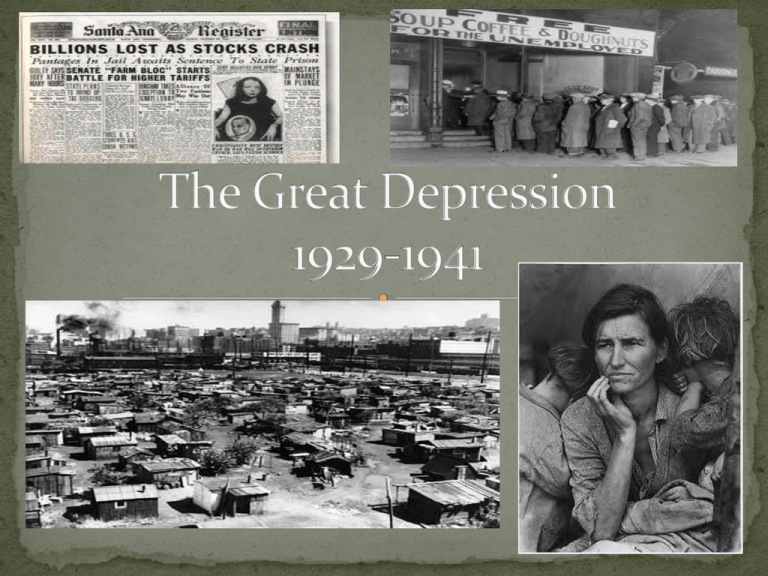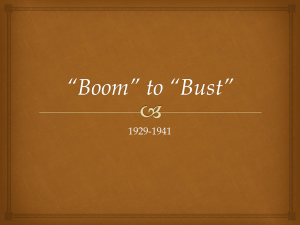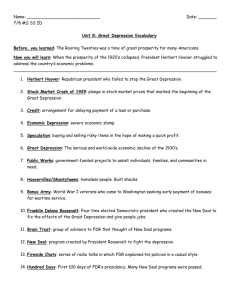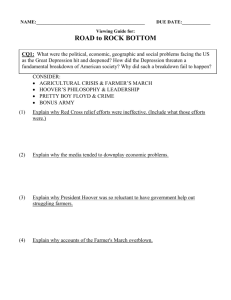The Great Depression 1929-1941
advertisement

The Great Depression was the worst economic crisis in the history of America Several flawed economic and political policies contributed to the stock market crash The Depression affected Americans of all classes The New Deal demanded significant spending on the federal level to combat the Depression The New Deal sought to solve the problems of the Depression by providing public work projects The New Deal changed the role of government in American life The impact of the New Deal affects American life today What underlying issues and conditions led to the Great Depression? Why were the policies of the Hoover Administration ineffective in dealing with the problems of the Depression? How did the Great Depression impact American society and the American dream? How did President Franklin D. Roosevelt change the role of the presidency in American History? How successful was the New Deal in solving the problems of the Great Depression and restoring American prosperity? 1.Massive uneven distribution of income 2.Stock Speculation“Get rich quick scheme” 3.Agriculture Problems 4.Overextension of Credit Depression Causes 5.Surplus of goods October 29, 1929-Black Tuesday marks the start of the Great Depression Panic selling-causes prices to drop By the last week in Oct. the bottom fell out of the stock market. Black Tuesday16 million shares sold, nearly worthless 30 billion lost in all Speculation- was a way of gambling with short-term investments.(buying on the margin) Speculators would buy stocks they thought would quickly rise in price. After the price of their stocks went up, they would sell the stock for a profit. A person who bought stock in Hershey Chocolate in August 1928, for example sold it in September 1929 , and made a 100% profit. Banks commonly paid an interest rate of 5-7%, making profit from stock much more attractive. People would buy on margin “pay only a fraction of a stock’s $ value” Borrowing the rest of the money from a stockbroker, Paying the broker back (plus commission) when the stock went up and the investor sold it. Buying on Margin Normal Start = $500 $500 / $100 (per share)= 5 shares of stock Shares cost $100/Share $500 = down payment (5%) = $10,000 / $100 (per share) = 100 Shares of stock Normal Buying on Margin 5 Shares x $200 = $1,000 100 Shares x $200 = $20,000 $20,000 -$9,500 = $10,500 $10,500 – $2,100 (20% Commission) = $8,400 Using above amounts = Stock value increases to $200 per share Buying Normal Buying on Margin Using the above amounts: Stocks worth $0 5 shares x $0 = $0 Loss of $500 100 shares x $0 = $0 Loss of $10,000 BIG PROBLEM= Still owe $9,500 During the Roaring 20’s margin buyers made fortunes. As long as stock prices kept going up, brokers were happy to lend money to speculators. As soon as prices began to decline, brokers asked investors to put more money down. (Margin Call) When the investor did not have more money to put down, the broker sold the stock and kept the proceeds as repayment for the loan. By summer of 1929, brokers had lent out more than $6 billion in margin loans to their customers. Saturated the market. Brokers started calling for there margins. Investors did not have cash to pay for the margin. Brokers were forces to sell the stocks. Panic Banks lent their cash reserves to stockbrokers. The brokers lost the money when their customers failed to repay the loan. Saving deposits were not federally insured Bank Runs- massive withdrawals, money not insured, bank closes-no money Thus resulting in millions of innocent people losing their savings in the financial crunch. By 1933, over 20% of banks had closed over, 10,000 across the U.S. since 1929 Keynesian Monetarist Fall in Demand was the Fed caused the cause Federal government must spend to stimulate Fed should print more money, lower interest rates, cut taxes Depression Raised interest rates Didn’t help banks Discouraged unsafe loans Return to the gold standard Tax increases in 1932 Fed Policy Easy money of the 20’s- low interest rates In 1928, the Fed raises interest rates and cut the money supply Tariffs 1931, Congress passed high tariffs Closes foreign trade In Cities On Farms Mass unemployment Falling prices Wage cuts Foreclosures Evictions Dust Bowl-worst environmental Bread lines-soup kitchens Hoovervilles disaster Sharecroppers/Migrant workers Migration Okies, west for jobs The Great Depression shatters many people’s life. The most popular song of the era sums up the disillusionment felt by many. Crime and kidnappings increase, birth rates drop, families are separated, malnutrition grows, # of orphans grows, # of homeless grows. Hoover doesn’t cause the Depression, but he is blamed. Hoover opposes direct federal aid Encourages Volunteerism Maintain jobs, wages, prices Wealthy to give to charity Local and state governments to provide jobs and relief Volunteerism Fails By 1932, Hoover begins a new plan- more direct Federal aid Government will loan money to banks and big businesses , farm cooperatives, creates public works Farm Board Revenue Act Increase taxes on wealthy Raises estate, corporate taxes RFC- aid to states Emergency Relief Act-July 32- $300 million in unemployment benefits WWI veterans camped out in D.C. demanding their bonus pay($1,000 by 45) 17,000+veterans march on D.C., camp in tents Congress did not pass the bill to give them their bonus early. Army Chief of Staff Douglas MacArthur ignores orders and violently removes the ‘Army’ Hoover Franklin D. Roosevelt Franklin D. Roosevelt won by a landslide. Hoover with all of his optimism and organizational skill, was defeated by the Depression and its crushing economic problems. What: Worst environmental disaster in American History When: 1931-1939 Where: Use the textbook pages 438-439, and the handout. Identify the following about the Dust Bowl Causes: Effect/Results: Responses: Causes Effects/Results Responses -Over farming -Drought -Removal of Grasslands -High Winds -Dust Pneumonia -Migration -Loss of topsoil, crops, livestock -Plagues -Static electricity -Soil Conservation Service -Forest Serviceshelter belts -People attempt many things to bring rain Form a small group and list everything you know or have heard about FDR and the New Deal Governor of New York Polio in 1921 Democrat Easily defeated Hoover in 1932 First President to embrace radio New Deal Broad Executive Power Increased Power of Federal Government Longest President Love-Hate Relationship “The only thing we have to fear is fear itself….” “A New Deal for the American people.” Relief- for the unemployed Recovery- to stimulate the economy Reform- laws to help lessen the threat of another economic disaster The Hundred Days- Enacted 15 major bills(March 9June 16 1933) Reform Relief The New Deal Recovery FDR declares a temporary bank shut down FDR assured the people their money would be safe in the bank- only reopens banks in sound financial shape Creates FDIC Fireside Chats- Radio address to people about the issues and promote the “New Deal” legislation. Restored their confidence Advisors with varied view points “Brain Trust” 1st female cabinet member, Frances Perkins. Truth-in-Securities Act: designed to eliminate fraud in the stock market. Honest info. to investors The Glass-Steagall Banking Act: prohibited banks from investing savings deposits in the stock market, which was too unpredictable to assure the safety of these funds. SEC is created to regulate the stock market and prevent fraud. Indian Reorganization Act of 1934- prevented government from selling unclaimed reservations land and selling it to people who were not Native American. Native Americans could determined how their lands would be used and managed. Encouraged Native Americans to establish their own government’s on reservations. For the unemployed Federal Emergency Relief Administration (FERA): Would distribute $ to state and local relief agencies. With days of the bill being passed $5 million dollars was handed out. Dole- Government Charity, opposed want work programs Civilian Conservations Corps (CCC): Put thousands of unemployed men and women to work each season on environmental projects. County, State and National parks, local projects, restoring forests Home Owners’ Loan Corporation (HOLC)- Loans to people behind on mortgage payments 10% of home owners use Farm Credit Administration (FCA)- Loans to farmers to keep farms and land Public Works Administration (PWA): Helped provide jobs for the unemployed. 4 million $3.3 billion to carry out public projects. Schools, dams, refurbishing government buildings, planning sewage systems, improving highways Stimulate the economy Goals was to increase the productivity of the economy National Industrial Recovery Act (NIRA): To help factories recovery faster Called for business leaders to confer and establish codes to set quality standards, production levels, prices, maximum work hours, minimum wages. Also declared that workers should be allowed to organize labor unions and bargain collectively. ----> Shorten work hours, which forced business to hire more people. Declared unconstitutional Recovery Established to help farmers that were hit hard by the Great Depression Paid farmers Subsidy, or financial assistance, to reduce the production of crops and the number of animals they raised. This would bring supply of agricultural products more in line with the demand for them, causing prices to rise. Declared unconstitutional Recovery Built dams in the Tennessee River to turn the river’s water power into electricity. Would also enrich the land, create fish-filled lakes that would in turn increase tourism, and provide jobs. Huge success $4.8 billion Relief Program Building projects including hospitals, schools, airports and playgrounds. Put unemployed teachers, painters, and writers back to work Improved the quality of life in communities across the nations 8 million jobs When the Supreme Court declared the NIRA was unconstitutional, workers lost the right to join a union and collectively bargain. Wagner act- restored those rights. It also set up the National Labor Relations Board, which was created to ensure that employer followed the new law. Soil Conservation Act- required farmers to reduce the acreage of the same crops the AAA had previously paid them not to plant, new farming techniques(Dust Bowl) Fair Labor and Standards Act: outlawed child labor, established a federal minimum wage, 40 hour work week, overtime pay Social Security Act: Old age pension system, survivors, unemployment insurance, aid for dependent mothers and children, disabled Expanded the Role of Government Federal Regulation Under the New Deal for the first time the federal government assumed responsibility for the economic welfare of individuals as well as for the health of the national economy at large. Deficit Spending Stock Market monitored FDR’s New Deal proved to be the turning point in the country’s history.





